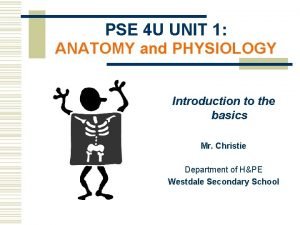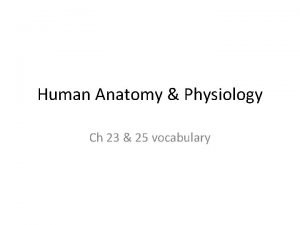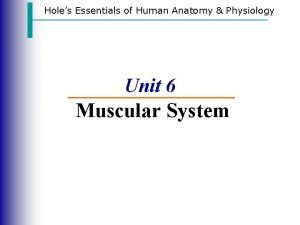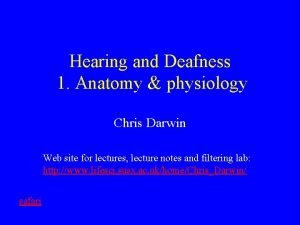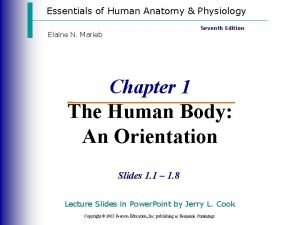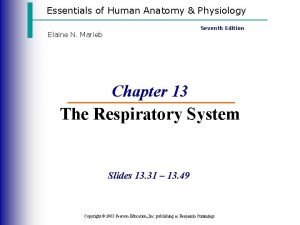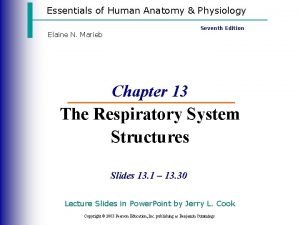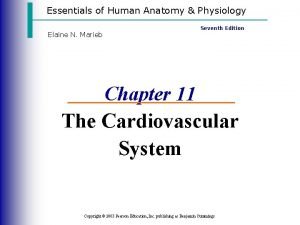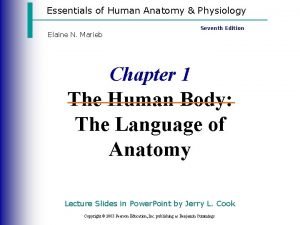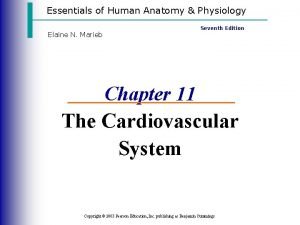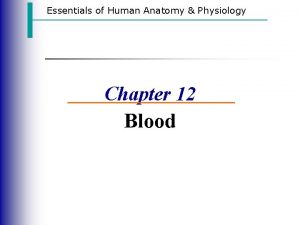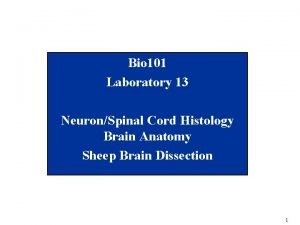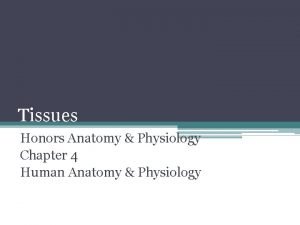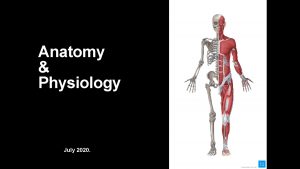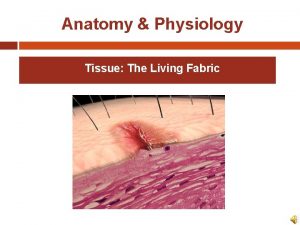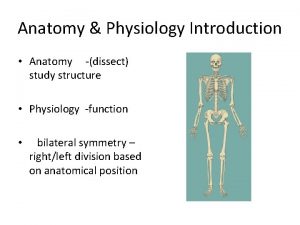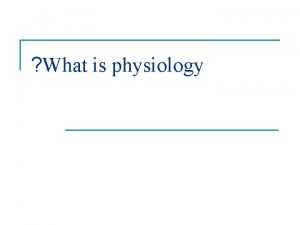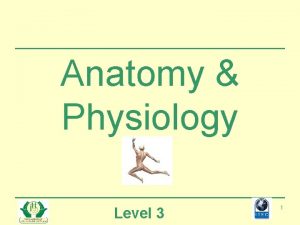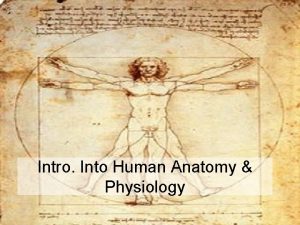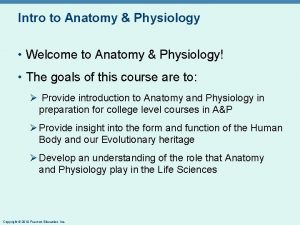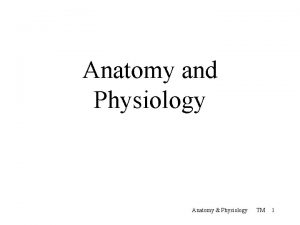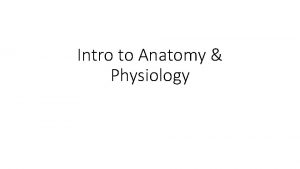Pregnancy Honors Anatomy Physiology Chapter 28 Pregnancy covers




































































- Slides: 68

Pregnancy Honors Anatomy & Physiology Chapter 28

Pregnancy • covers from fertilization birth • period of time for this called gestation • use date of LMP (last menstrual period) to start count ▫ 280 days = full term ▫ fertilization 8 wks = embryonic period (embryo) ▫ 9 wks delivery conceptus called a fetus


Conception • once a month an ovum is released ▫ ovum- A female egg • secondary oocyte moves through the fallopian tube to the uterus ▫ where the baby develops during pregnancy • if not fertilized it disintegrates and is flushed away with menstruation

Fertilization • sperm‘s nucleus combines with nucleus of secondary oocyte 1 diploid cell called a zygote


Sperm • millions of sperm ejaculated • most either do not make it up vagina or are killed by the acidic environment • if female ovulatory, some sperm will make it thru endocervical canal (mucus clear, slippery) if not ovulatory: most sperm will be blocked • sperm that reach uterine cavity: ▫ whipped around by contractions of myometrium ▫ many phagocytosed

Sperm Capacitation • must be done w/in 2 – 10 hrs or cannot fertilize 1. enhances motility 2. membrane becomes more fragile ▫ membrane proteins removed by vaginal secretions


Acrosome Reaction • lysosomal enzymes released from acrosome • allows sperm head to penetrate zona pellucida & reach the plasma membrane of the secondary oocyte • membranes then fuse • sperm nucleus decondenses forming male pronucleus •

Polyspermy • entry of several sperm into ova • occurs in some animals , not in humans • after 1 sperm has entered Ca++ released from oocyte’s ER cytoplasm result in: 1. Cortical Reaction 2. activates 2 nd meiotic division

Cortical Reaction

Fertilization • secondary oocyte completes meiosis forming female pronucleus which joins with male pronucleus 2 n fertilized ovum (zygote)

Embryonic Development • immediately after zygote formed chromosomes duplicate & cell prepares for mitosis ▫ 1 st mitotic division ~36 hrs ▫ 2 identical cells called blastomeres • initially mitosis repeated w/out cell growth developing very small cells with high surface-tovolume ratios • ~72 hrs: loose collection of cells forming a berryshaped cluster of 16 or more cells = morula

Morula Blastocyst • mitosis continues as embryo is moving through tube uterus • ~4 -5 days: fluid begins to collect in cavity: now called a blastocyst (2 parts) ▫ 1 layer flattened cells =trophoblast cells ▫ small cluster of 20 – 30 rounded cells = inner cell mass


Blastocyst • inner cell mass becomes the embryonic disc • Trophoblastic cells add adhesion molecules to plasma membrane eventually becomes placenta

Implantation: 4 Weeks • blastocyst initially floats around endometrial cavity 2 - 3 days after entering through tube ▫ nourishment from glycoproteins in uterine secretions • 6 – 7 days after ovulation implantation occurs ▫ E & P have prepared endometrium ▫ trophoblastic cells: adhesion molecules bind to the extracellular parts of the endometrial cells (collagen & others) ▫ https: //www. youtube. com/watch? v=ld. LWUpt 82 h I

Trophoblast • after implantation 2 layers: 1. Cytotrophoblast ▫ inner layer / retain plasma membranes 2. Syncytiotrophoblast ▫ outer layer/ lose membranes invade into endometrium blastocyst surrounded by blood from degraded maternal vessels

http: //www. as. wvu. edu/~s raylman/physiology/cleava ge_implant. html

https: //www. nlm. nih. gov/medli neplus/ency/anatomyvideos/00 0025. htm

h. CG • human chorionic gonadotropin (+preg. test) • secreted by trophoblasts • target: corpus luteum • action: 1. keep secretion of P & E ▫ ▫ so chorion is taking control from pituitary called “rescuing the corpus luteum” 2. protease activity ▫ acts as autocrine growth factor that promotes placental development

5 Weeks • is the start of the "embryonic period” : when all the baby's major systems and structures develop. • embryo's cells multiply and start to take on specific functions = differentiation • blood cells, kidney cells, & nerve cells start to develop. • brain, spinal cord, and heart begin to develop. • GI tract starts to form.

5 Weeks • during this time in the first trimester that the baby is most at risk for damage from things that may cause birth defects. • This includes certain medicines, illegal drug use, heavy alcohol use, infections such as rubella, and other factors.

6 Week Embryo

6 – 7 Weeks • arm and leg buds start to grow. • brain forms into 5 different areas ▫ some cranial nerves are visible. • eyes and ears begin to form • tissue grows that will become spine & other bones. • heart continues to grow and now beats at a regular rhythm.

Development of the Heart http: //www. indiana. ed u/~anat 550/cvanim/

8 Weeks • arms & legs longer • hands & feet begin to form, look like little paddles • brain continues to grow • lungs start to form

1 st Trimester

12 -14 Weeks • eyelids close, will not reopen until about the 28 th week • face is well-formed • limbs long and thin. • nails appear on the fingers & toes • genitals appear • liver is making red blood cells • head is very large -- about half of baby's size. • can now make a fist. • tooth buds appear for baby teeth.

15 – 18 Weeks • skin is almost transparent • fine hair called lanugo develops on head • muscle tissue & bones keep developing, bones become harder • baby begins to move and stretch. • liver and pancreas produce secretions •

Weeks 19 - 21 • baby can hear • baby is more active, continues to move & float around • mother may feel a fluttering in the lower abdomen= quickening (when mom can feel baby's first movements) • by the end of this time, baby can swallow ▫ swallows amniotic fluid

Week 22 • lanugo hair covers entire body • meconium, baby's first bowel movement, is made in the intestinal tract • eyebrows & lashes appear • baby is more active with increased muscle development • mother can feel the baby moving • baby's heartbeat can be heard with stethoscope • nails grow to the end of fingers

Lanuga


Week 23 - 25 • bone marrow begins to make blood cells • lower airways of the baby's lungs begin to develop ▫ baby inhales amniotic fluid • baby begins to store fat

Week 26 • • • eyebrows & eyelashes are well-formed all parts of baby's eyes are developed startle response intact footprints & fingerprints forming air sacs form in baby's lungs ▫ lungs are still not ready to work outside the womb


Weeks 27 - 30 • brain grows rapidly • nervous system is developed enough to control some body functions • eyelids can open and close • the respiratory system, while immature, produces surfactant ▫ helps the air sacs fill with air

Weeks 31 - 34 • baby grows quickly & gains fat • rhythmic breathing occurs ▫ baby's lungs are not fully mature • bones are fully developed ▫ still soft • begins storing: ▫ iron ▫ calcium ▫ phosphorus


35 – 37 Weeks • weighs about 5 1/2 lbs • baby keeps gaining weight ▫ will probably not get much longer • skin is not as wrinkled as fat forms under the skin • definite sleeping patterns • heart & blood vessels are complete • muscles & bones are fully developed


38 - 40 Weeks • • • lanugo gone except for upper arms & shoulders fingernails may extend beyond fingertips small breast buds present on both sexes head hair is now coarse & thicker 40 th week of pregnancy it has been 38 weeks since conception

Labor & Delivery • 1 st Stage of Labor ▫ Early Labor ▫ Active Labor ▫ Transition • 2 nd Stage of Labor • 3 rd Stage of Labor

True vs False Labor: Williams Obstetrics (22 nd edition) • • • True Labor: Contractions occur at regular intervals Intensity gradually increases Discomfort is in the back and abdomen. *Cervix dilates. Discomfort is not stopped by sedation • “False Labor” • Contractions are irregular • Intensity remains the same • No cervical dilatation • Discomfort relieved by sedation



Length of first stage labor in healthy nulliparous and multiparous childbearing women adapted from Albers L. (2007) bold = nullips, italics = multips Mean (hrs) 95 th percentile (hrs) Friedman (1978) 4. 1 8. 5 Kilpatrick & Laros (1989) 8. 1 16. 6 Albers, Schiff & Gorwoda (1996) 7. 7 19. 4 Albers (1999) 7. 7 17. 5 Friedman (1978) 2. 4 7. 0 Kilpatrick & Laros (1989) 5. 7 12. 5 Albers (1996) 5. 7 13. 7 Albers (1999) 5. 6 13. 8

Early Labor • often longest part of birthing process ▫ sometimes lasting 2 to 3 days • uterine contractions: ▫ mild to moderate (you can talk while they are happening) and last about 30 to 45 seconds. ▫ often irregular (5 to 20 minutes apart) and may even stop for a while

Early Labor • open (dilate) the cervix to about 3 cm (1 in. ). 1 st time mothers can have many hours of early labor without the cervix dilating ▫ dilation progresses 1 cm/2 hr in “true” labor • cervix has to efface (thin) ▫ starts 2 – 3 cm paper thin(by end of active phase)


Presentation

Passenger: Station • Engagement ▫ aka “dropping” or “lightening” ▫ @ the level of ischial spines = 0 station ▫ above ischial spines �-5 to -1 �-5 = unengaged ▫ below ischial spines �+1 to +5 �+5 = crowning

Active Labor • starts when the cervix is about 3 cm (1. 2 in. ) to 4 cm (1. 6 in. ) dilated • is complete when the cervix is fully effaced and dilated and the baby is ready to be pushed out

Active Labor • compared with early labor contractions during active labor are more intense & more frequent (every 2 to 3 minutes) and longer-lasting (50 to 70 seconds)

Transition (few min, to a few hours) �last part of active labor: cervix dilates from 8 to a full 10 centimeters �contractions usually very strong �coming every two and a half to three minutes �lasting a minute or more

The Passenger Fontanelles and Sutures


Second Stage of Labor • 10 cm to birth of baby • pushing or expulsion • contraction pattern may alter • up to 2 hrs for 1 st shorter for others

Birth • perineal management ▫ stretching tissues ▫ episiotomy if necessary


• Apgar score is a score given at one, five and ten minutes after the birth of a child. A score of 7 -9 is normal.

Third Stage of Labor • the placenta • 5 to 30 minutes…. or more • signs of placental separation: small gush of blood • inspection


Pathways of Placement of Anesthetics for Labor Pain Eltzschig H et al. N Engl J Med 2003; 348: 319 -332

Labor and Delivery • http: //www. webmd. com/baby/video/eddlemanwhat-expect-during-labor • http: //www. dailymotion. com/video/x 12 exwi_la bor-and-birth-babycenter-video_news

 Chapter 13 anatomy and physiology of pregnancy
Chapter 13 anatomy and physiology of pregnancy The central sulcus divides which two lobes? (figure 14-13)
The central sulcus divides which two lobes? (figure 14-13) Chapter 1 introduction to human anatomy and physiology
Chapter 1 introduction to human anatomy and physiology Anatomy and physiology chapter 8 special senses
Anatomy and physiology chapter 8 special senses Anatomy and physiology chapter 2
Anatomy and physiology chapter 2 Heat and cold
Heat and cold Anatomy and physiology coloring workbook figure 14-1
Anatomy and physiology coloring workbook figure 14-1 Chapter 10 blood anatomy and physiology
Chapter 10 blood anatomy and physiology Anatomy and physiology chapter 15
Anatomy and physiology chapter 15 Anatomy and physiology chapter 1
Anatomy and physiology chapter 1 Holes anatomy and physiology chapter 1
Holes anatomy and physiology chapter 1 Anatomy and physiology chapter 15
Anatomy and physiology chapter 15 Chapter 1 introduction to anatomy and physiology
Chapter 1 introduction to anatomy and physiology Chapter 2 human reproductive anatomy and physiology
Chapter 2 human reproductive anatomy and physiology Male vs female skeleton pelvis
Male vs female skeleton pelvis Chapter 6 general anatomy and physiology
Chapter 6 general anatomy and physiology Cephalic cranial
Cephalic cranial Definition of spotting during pregnancy
Definition of spotting during pregnancy Physiology of lungs
Physiology of lungs Tattoo anatomy and physiology
Tattoo anatomy and physiology Anatomy science olympiad
Anatomy science olympiad Incomplete flower
Incomplete flower Bone metabolism
Bone metabolism Ulcer anatomy
Ulcer anatomy Sheep liver lobes
Sheep liver lobes Epigastric region
Epigastric region Epigastric region
Epigastric region Cytoplasmic granules
Cytoplasmic granules 3 layers of muscle
3 layers of muscle Http://anatomy and physiology
Http://anatomy and physiology Appendix anatomy and physiology
Appendix anatomy and physiology Aohs foundations of anatomy and physiology 1
Aohs foundations of anatomy and physiology 1 Aohs foundations of anatomy and physiology 2
Aohs foundations of anatomy and physiology 2 Anatomy and physiology of swine
Anatomy and physiology of swine Teks anatomy and physiology
Teks anatomy and physiology Science olympiad anatomy and physiology 2020 cheat sheet
Science olympiad anatomy and physiology 2020 cheat sheet Physiology of stomach ppt
Physiology of stomach ppt Anatomy and physiology diabetes
Anatomy and physiology diabetes Aohs foundations of anatomy and physiology 1
Aohs foundations of anatomy and physiology 1 Aohs foundations of anatomy and physiology 1
Aohs foundations of anatomy and physiology 1 Anatomy and physiology
Anatomy and physiology Cornell notes for anatomy and physiology
Cornell notes for anatomy and physiology Anatomy and physiology edition 9
Anatomy and physiology edition 9 Holes essential of human anatomy and physiology
Holes essential of human anatomy and physiology Anatomy and physiology unit 7 cardiovascular system
Anatomy and physiology unit 7 cardiovascular system Anatomy and physiology
Anatomy and physiology The speed at which the body consumes energy
The speed at which the body consumes energy Aohs foundations of anatomy and physiology 1
Aohs foundations of anatomy and physiology 1 Anatomy and physiology exam 1
Anatomy and physiology exam 1 Welcome to anatomy and physiology
Welcome to anatomy and physiology Physiology of the foot and ankle
Physiology of the foot and ankle Anatomy and physiology of psoriasis
Anatomy and physiology of psoriasis Pse 4
Pse 4 Pancreas anatomy histology
Pancreas anatomy histology Anatomy and physiology vocabulary
Anatomy and physiology vocabulary Anatomy and physiology
Anatomy and physiology Anatomy and physiology
Anatomy and physiology Anatomy and physiology
Anatomy and physiology Organ orientation
Organ orientation Anatomy and physiology
Anatomy and physiology Anatomy and physiology
Anatomy and physiology Anatomy and physiology
Anatomy and physiology Dorsifelxion
Dorsifelxion Anatomy and physiology
Anatomy and physiology Anatomy and physiology
Anatomy and physiology Anatomy and physiology
Anatomy and physiology Figure 10-1 blood
Figure 10-1 blood Human anatomy and physiology 10th edition
Human anatomy and physiology 10th edition Sheep brain
Sheep brain




















































